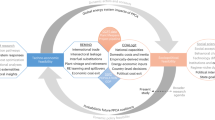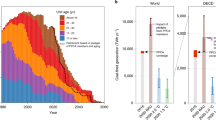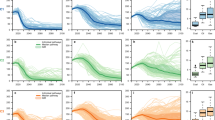Abstract
In IPCC pathways limiting warming to 1.5 °C, global coal power generation declines rapidly due to its emissions intensity and substitutability. However, we find that in countries heavily dependent on coal—China, India and South Africa—this translates to a national decline twice as rapid as that achieved historically for any power technology in any country, relative to system size. This raises questions about socio-political feasibility. Here we constrain an integrated assessment model to the Powering Past Coal Alliance’s differentiated phase-out timelines of 2030 in Organisation for Economic Co-operation and Development/European Union and 2050 elsewhere which, for large coal consumers, lies within the range of historical transitions. We find that limiting warming to 1.5 °C then requires CO2 emissions reductions in the global North to be 50% more rapid than if this socio-political reality is ignored. This additional mitigation is focused on Europe and the United States, in transport and industry and implies more rapid decline in global oil and gas production.
This is a preview of subscription content, access via your institution
Access options
Access Nature and 54 other Nature Portfolio journals
Get Nature+, our best-value online-access subscription
$29.99 / 30 days
cancel any time
Subscribe to this journal
Receive 12 print issues and online access
$209.00 per year
only $17.42 per issue
Buy this article
- Purchase on Springer Link
- Instant access to full article PDF
Prices may be subject to local taxes which are calculated during checkout





Similar content being viewed by others
Data availability
The results data and key source data in the figures (including those in Supplementary Information) are available via Zenodo at https://zenodo.org/record/7313951#.Y25lpuTP2Uk (ref. 55).
Code availability
The underlying code (mathematical equations) for the model is available via GitHub (https://github.com/etsap-TIMES/TIMES_model)56. The full model database is also available via Zenodo (https://zenodo.org/record/7313951#.Y25lpuTP2Uk)55. Given the complexity of the model, further guidance will be provided on model assumptions upon reasonable request from the corresponding author.
References
Hendryx, M. et al. Impacts of coal use on health. Annu. Rev. Publ. Health 41, 397–415 (2020).
Spencer, T. et al. The 1.5 °C target and coal sector transition: at the limits of societal feasibility. Clim. Policy 18, 335–351 (2017).
World Energy Balances 2019: Summary Energy Balances (IEA, 2019); https://doi.org/10.5257/iea/web/2019
Clarke, L. et al. in Climate Change 2014: Mitigation of Climate Change. Working Group III Contribution to the IPCC Fifth Assessment Report (eds Edenhofer, O. et al.) (Cambridge Univ. Press, 2015).
Gilabert, P. & Lawford-Smith, H. Political feasibility: a conceptual exploration. Polit. Stud. 60, 809–825 (2012).
Geels, F. W. Regime resistance against low-carbon transitions: Introducing politics and power into the multi-level perspective. Theor. Cult. Soc. 31, 21–40 (2014).
Wilson, C. & Grubler, A. Lessons from the history of technological change for clean energy scenarios and policies. Nat. Resour. Forum 35, 165–184 (2011).
Johnson, N. et al. Stranded on a low-carbon planet: implications of climate policy for the phase-out of coal-based power plants. Technol. Forecast. Soc. Change 90, 89–102 (2015).
Seto, K. C. et al. Carbon lock-in: types, causes, and policy implications. Annu. Rev. Environ. Resour. 41, 425–452 (2016).
Unruh, G. C. Understanding carbon lock-in. Energy Pol. 28, 817–830 (2000).
Loftus, P. J. et al. A critical review of global decarbonization scenarios: what do they tell us about feasibility? Wiley Interdiscip. Rev. Clim. Change 6, 93–112 (2015).
van Sluisveld, M. A. E. et al. Comparing future patterns of energy system change in 2 °C scenarios with historically observed rates of change. Glob. Environ. Change 35, 436–449 (2015).
Napp, T. et al. Exploring the feasibility of low-carbon scenarios using historical energy transitions analysis. Energies 10, 116 (2017).
Vinichenko, V. et al. Historical precedents and feasibility of rapid coal and gas decline required for the 1.5 °C target. One Earth 4, 1477–1490 (2021).
Jewell, J. & Cherp, A. On the political feasibility of climate change mitigation pathways: Is it too late to keep warming below 1.5C? Wiley Interdiscip. Rev. Clim. Change 11, 621 (2020).
Jewell, J. et al. Prospects for powering past coal. Nat. Clim. Chang. 9, 592–597 (2019).
Le Quéré, C. et al. Drivers of declining CO2 emissions in 18 developed economies. Nat. Clim. Chang. 9, 213–217 (2019).
Mehta, U. S. et al. In Pursuit of a Low Fossil Energy Future: Interrogating Social, Political and Economic Drivers and Barriers in India’s Energy Transition (Friedrich Ebert Stiftung, 2017); https://www.fes-asia.org/news/in-pursuit-of-a-low-fossil-energy-future/
Lamb, W. F. & Minx, J. C. The political economy of national climate policy: architectures of constraint and a typology of countries. Energy Res. Soc. Sci. 64, 101429 (2020).
Grübler, A. et al. Dynamics of energy technologies and global change. Energy Policy 27, 247–280 (1999).
Grubler, A. Energy transitions research: insights and cautionary tales. Energy Policy 50, 8–16 (2012).
Geels, F. W. Technological transitions as evolutionary reconfiguration processes: a multi-level perspective and a case-study. Res. Policy 31, 1257–1274 (2002).
The End of Coal is in Sight (Powering Past Coal Alliance, 2022); https://poweringpastcoal.org/
Fleurbaey, M. et al. in Climate Change 2014: Mitigation of Climate Change. Working Group III Contribution to the IPCC Fifth Assessment Report (eds Edenhofer, O. et al.) (Cambridge Univ. Press, 2015).
Arbelaez, J. P. & Marzolf, N. C. Power & Possibility: The Energy Sector in Jamaica (InterAmerican Development Bank, 2010); https://publications.iadb.org/publications/english/document/Power-and-Possibility-The-Energy-Sector-in-Jamaica.pdf
Keppo, I. et al. Exploring the possibility space: taking stock of the diverse capabilities and gaps in integrated assessment models. Environ. Res. Lett. 16, 053006 (2021).
Pye, S. et al. Modelling ‘Leadership-Driven’ Scenarios of the Global Mitigation Effort (UCL Energy Institute, 2019); https://www.theccc.org.uk/publication/modelling-leadership-driven-scenarios-of-theglobal-mitigation-effort-ucl-energy-institute/
Bi, S. et al. Dynamic evaluation of policy feasibility, feedbacks and the ambitions of COALitions. Nat. Clim. Chang. https://doi.org/10.21203/rs.3.rs-827021/v1 (2023).
van Beek, L. et al. Anticipating futures through models: the rise of Integrated Assessment Modelling in the climate science-policy interface since 1970. Glob. Environ. Change 65, 102191 (2020).
Climate Change Minister Claire Perry Launches Powering Past Coal Alliance at COP23 (PPCA, 2017); https://www.poweringpastcoal.org/news/PPCA-news/Powering-Past-Coal-Alliance-launched-COP23
Blondeel, M. et al. Moving beyond coal: exploring and explaining the Powering Past Coal Alliance. Energy Res. Soc. Sci. 59, 101304 (2020).
Low, S. & Schäfer, S. Is bio-energy carbon capture and storage (BECCS) feasible? The contested authority of integrated assessment modeling. Energy Res. Soc. Sci. 60, 101326 (2020).
Grant, N. et al. The policy implications of an uncertain carbon dioxide removal potential. Joule 5, 2593–2605 (2021).
Iyer, G. Diffusion of low-carbon technologies and the feasibility of long-term climate targets. Technol. Forecast. Soc. Change 90, 103–118 (2015).
Gambhir, A. et al. Assessing the feasibility of global long-term mitigation scenarios. Energies 10, 89 (2017).
Li, F. G. N. & McDowall, W. Transparency and quality in modelling energy transitions. In Proc. 8th International Sustainability Transitions Conference (IST 2017) (Chalmers University of Technology, CIIST and STRN, 2017); https://www5.shocklogic.com/scripts/jmevent/programme.php?client_Id=KONGRESS&project_Id=17361
Keepin, B. & Wynne, B. Technical analysis of IIASA energy scenarios. Nature 312, 691–695 (1984).
Patterson, J. J. et al. Political feasibility of 1.5˚C societal transformations: the role of social justice. Curr. Opin. Environ. Sustain. 31, 1–9 (2018).
Dooley, K. et al. Co-producing climate policy and negative emissions: trade-offs for sustainable land-use. Glob. Sustain. 1, e3 (2018).
Ellenbeck, S. & Lilliestam, J. How modelers construct energy costs: discursive elements in Energy System and Integrated Assessment Models. Energy Res. Soc. Sci. 47, 69–77 (2019).
Stoddard, I. et al. Three decades of climate mitigation: why haven’t we bent the global emissions curve? Annu. Rev. Environ. Resour. 46, 653–689 (2021).
DeCarolis, J. et al. Formalizing best practice for energy system optimization modelling. Appl. Energy 194, 184–198 (2017).
Global coal to clean power transition statement. In UN Climate Change Conference UK 2021 (COP26) (UK Government and United Nations Climate Change, 2021); https://ukcop26.org/global-coal-to-clean-power-transition-statement/
Welsby, D. et al. Unextractable fossil fuels in a 1.5 °C world. Nature 597, 230–234 (2021).
Erickson, P. et al. Why fossil fuel producer subsidies matter. Nature 578, E1–E4 (2020).
Biomass in a Low-Carbon Economy (CCC, 2018); https://www.theccc.org.uk/publication/biomass-in-a-low-carbon-economy/
Huppmann, D., Rogelj, J., Kriegler, E., Krey, V. & Riahi, K. A new scenario resource for integrated 1.5 °C research. Nat. Clim. Chang. 8, 1027–1030 (2018).
Fuss, S. et al. Negative emissions—part 2: costs, potentials and side effects. Environ. Res. Lett. 13, 063002 (2018).
Creutzig, F. et al. Bioenergy and climate change mitigation: an assessment. Glob. Change Biol. Bioenergy 7, 916–944 (2015).
Integrated Assessment of Global Environmental Change with IMAGE 3.0: Model Description and Policy Applications (PBL, 2014); https://www.pbl.nl/en/publications/integrated-assessment-of-global-environmental-change-with-IMAGE-3.0
Fricko, O. et al. The marker quantification of the Shared Socioeconomic Pathway 2: a middle-of-the-road scenario for the 21st century. Glob. Environ. Change 42, 251–267 (2017).
Rogelj, J. et al. Scenarios towards limiting global mean temperature increase below 1.5 °C. Nat. Clim. Chang. 8, 325–332 (2018).
Marchetti, C. & Nakicenovic, N. The Dynamics of Energy Systems and the Logistic Substitution Model (IIASA, 1979); http://pure.iiasa.ac.at/id/eprint/1024/
IPCC. Special Report on Global Warming of 1.5 °C (eds Masson-Delmotte, V. et al.) (WMO, 2018).
Muttitt, G., Price, J., Pye, S. & Welsby, D. Model and results data from socio-political feasibility of coal power phaseout and its role in mitigation pathways. Zenodo https://doi.org/10.5281/zenodo.7313951 (2022).
The Integrated MARKAL-EFOM System (TIMES) – a bottom-up optimization model for energy-environment systems. GitHub https://github.com/etsap-TIMES/TIMES_model (2022).
Acknowledgements
We thank S. Bi, R. Bridle, W. McDowall, G. Peters, M. Phillips and S. Raizada for their reviews of the draft manuscript. For J.P. and D.W., this work has been supported by the UK Energy Research Centre Phase 4 (grant no. EP/S029575/1).
Author information
Authors and Affiliations
Contributions
G.M. designed the study, with contributions from S.P. G.M. compiled the historical data and conducted the comparison of the phase-out pace. J.P., S.P. and D.W. conducted the TIAM-UCL modelling, with contributions from G.M. S.P. led on the presentation of the modelling results. D.W. led on the Supplementary Information. G.M. led on the drafting of the manuscript, with contributions from all authors.
Corresponding author
Ethics declarations
Competing interests
The authors declare no competing interests.
Peer review
Peer review information
Nature Climate Change thanks Gang He and the other, anonymous, reviewer(s) for their contribution to the peer review of this work.
Additional information
Publisher’s note Springer Nature remains neutral with regard to jurisdictional claims in published maps and institutional affiliations.
Supplementary information
Supplementary Information
Supplementary Sections 1–6, including Tables 1–12, Figs. 1 and 2 and additional methodological detail.
Rights and permissions
Springer Nature or its licensor (e.g. a society or other partner) holds exclusive rights to this article under a publishing agreement with the author(s) or other rightsholder(s); author self-archiving of the accepted manuscript version of this article is solely governed by the terms of such publishing agreement and applicable law.
About this article
Cite this article
Muttitt, G., Price, J., Pye, S. et al. Socio-political feasibility of coal power phase-out and its role in mitigation pathways. Nat. Clim. Chang. 13, 140–147 (2023). https://doi.org/10.1038/s41558-022-01576-2
Received:
Accepted:
Published:
Issue Date:
DOI: https://doi.org/10.1038/s41558-022-01576-2
This article is cited by
-
Supply-side climate policy and fossil fuels in developing countries: a neo-Gramscian perspective
International Environmental Agreements: Politics, Law and Economics (2024)
-
Increased ambition is needed after Glasgow
Nature Climate Change (2023)
-
Powering past coal is not enough
Nature Climate Change (2023)
-
Global fossil fuel reduction pathways under different climate mitigation strategies and ambitions
Nature Communications (2023)



